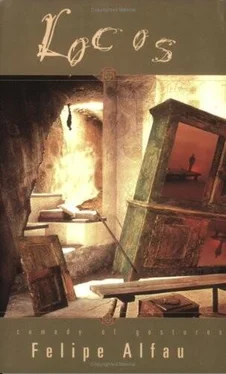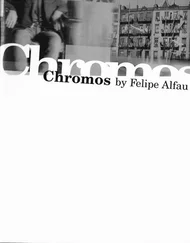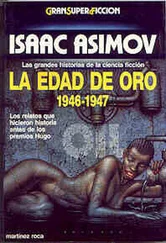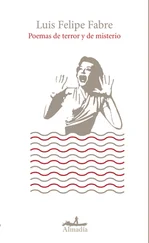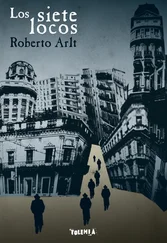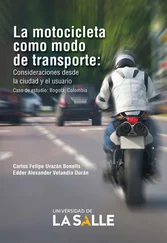“You know Garcia, the poet across the street from my house? Well, I know he is going to die soon. I never liked him. always reciting his secondhand poems about life and nature to everyone. Hmm. he is already blind and I know he will die. Hmm I could see the sign of agony in his face. And it is that girl, Lunarito, who lives with him. Hmm. yes, she is killing him. she is a beast. Hmm. and those two big gloomy dogs he keeps, like reincarnations of souls in pain. Hmm. yes. They have been howling at night. Hmm. ”
Doña Micaela loved death. It was an obsession with her that had assumed indecent proportions. She spoke of nothing else, she thought of nothing else, and people began to notice it subconsciously. She always appeared as if by miracle on the spot and everyone began to fear her presence. There was that wax figure air about her, that cloud of horror that seemed to hang about her person. There was that deep look in her eyes that seemed to search for the corpse in everyone she met, that looked for the death that is latent in every living being. That drilling look of hers that penetrated the skin and caressed the skull, that boring look that reminded everyone she saw of the fact that his days were counted. That look which enclosed one like a shroud.
She also walked in a jerky manner as if she were a stiff, mechanical dummy. With her black clothes at night, in a lonely, dark street, she must have been more than enough to frighten the most courageous person, and streets were lonely and dark then in the Barrio de Salamanca.
And then I found out another important thing about Doña Micaela Valverde.
She suffered from a strange sickness. Once every year and for the space of two or three months she went into a state of unconsciousness which had all the aspects of death. It was something like catalepsy but more acute. She grew cold and rigid and all efforts to bring her to were vain.
In the beginning these spells were not so acute and she could hear and feel although she could not move or speak. But with time they grew worse and she lay exactly as if she were dead. Her features grew sharper and set into a cadaverous expression, and when she woke up she could remember nothing at all.
By and by she was able to detect the approach of these spells every year and then she went to say farewell to the few acquaintances she had kept, as if she were going for a vacation to the other world. By and by these tours to her friends became a ritual which took place every year about the same time: the spring. And then she retired to her chamber and her house was closed and she lay dead to the world.
Dr. José de los Rios, who attended her more or less, said to me one day:
“Her case interests me and I would like to know more about it, but she won’t tell me. I believe she enjoys her condition. She likes to die periodically and I do not think she really wants me to cure her. She innocently believes that we physicians are enemies of death. I know that she dislikes me decidedly, but it amuses me to treat her and threaten her with life. It is surprising how she hates life. She has the same repugnance for life that most people have for death. I mean a repugnance for the obvious manifestations of it, not exempt from slight curiosity. She feels as revolted by the presence of a healthy-looking person as a normal being is by the proximity of a decayed corpse. She hates life.”
Doña Micaela Valverde had told little about herself to Dr. de los Rios. However, she had told him that she sensed the approach of her attacks by the long spells of melancholia that preceded them. For almost a month before one of these attacks she felt a sadness which assumed maddening proportions and almost verged on insanity. Then, as the attack neared, cramps began to steal all over her body at regular intervals and she knew it was time to make her preparations.
As I have said, in the beginning these attacks were milder; she lay motionless but her eyelids quivered and sometimes tears rolled from her eyes. She could see, hear and smell and sometimes even feel. But with time these attacks became more severe. She lost consciousness, was seized by complete rigor mortis, her temperature decreased until she was cold and the most sensitive stethoscope could not detect the beating of her heart. In that manner she lay for two or three months in her bed, in a room where the curtains had been drawn, having told her elderly maid beforehand not to give her any attention.
The poor maid went about the house with supreme indifference. She had apparently become used to these things. She arranged things, put everything in order without even looking into her mistress’s room, and thus time went by, until one day Doña Micaela would wake up and stagger out of bed hardly able to walk. Then the old maid would see the door of her mistress’s room open and Doña Micaela come reeling down the corridor like a living corpse, mumbling in a hollow voice:
“I have been dead. I have been dead. ”
The maid shook her head sadly and went about her duties.
Dr. José de los Rios had examined Doña Micaela during one of her attacks and had said to me:
“I have made all the tests that science knows of for such cases, and I tell you that she is really dead. She dies for two or three months and then she is resuscitated.”
“But that is not possible. It must be an acute attack of catalepsy or something like that.”
“I have made all the tests and I tell you that she is really dead.”
Dr. de los Rios insisted, but I could not be convinced.
Soon there was a superstition about Doña Micaela Valverde, and people began to call her the dead woman. No one dared approach her. Everybody avoided her. Children ran away from her, frightened. The only people who continued to befriend her were her old maid and the undertaker down the street.
Doña Micaela had foreseen the danger of being buried during one of her attacks and she had told her maid not to consent to such a thing until it was absolutely necessary, and under no circumstances to allow the undertaker or anyone who called himself a relative to come to the house during the spell. She seemed to know almost as much about the living as she knew about the dead.
And Doña Micaela went about lonely. She left her house at dusk and walked along the outskirts of the city, seized by infinite sadness and melancholia, and then she wandered in the direction of the church and spent a long time there in a dark corner, praying. Her sadness became more persistent and she went by with bowed head. She cried often and she cried more when she saw people receding from her.
Everyone had left her, everyone fled from the dense atmosphere of death which wrapped her, and when I saw her at that time I fancied that during these periods of her life her features had softened and there was more of a human expression in her face.
However, the repeated visits of death had branded her. Death had left with his deep footprints an indelible mark upon her whole countenance. Her complexion had assumed a greenish hue, her eyes were sunken and surrounded by black shadows, and as she passed by she left a trail of that peculiar odor which was not precisely unpleasant. It was a slightly rancid odor with a strong suggestion of withered orange blossoms and it hit one’s nostrils with a thud.
And then there was that look in her great sunken eyes, that look that searched for death in everyone she met. But now that look, too, had been softened, it no longer had that former spark of mockery, it was only a long, sad look, often veiled by tears.
Yes. There was a profound hidden beauty in Doña Micaela, and she might have been an intensely attractive woman. As a matter of fact, she had been married three times. Her two first husbands died and the third one, called Cendreras, left her during one of her death spells.
Читать дальше
